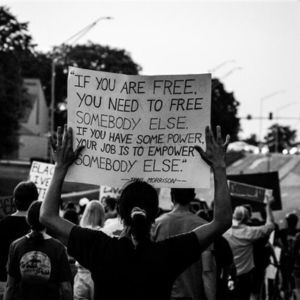Photo by Clay Banks on Unsplash
There must exist a paradigm, a practical model for social change that includes an understanding of ways to transform consciousness that are linked to efforts to
transform structures.
~ bell hooks, Killing Rage: Ending Racism
When it comes to social justice, there are several key factors to consider. While this list is not exhaustive, here are some important factors to be aware of:
- Equality vs. Equity: Social justice emphasizes the pursuit of equity rather than mere equality. Equality focuses on treating everyone the same, while equity recognizes that individuals have different starting points and may require different support or resources to achieve fairness. Equality aims to address systemic disadvantages and ensure that everyone has an equal opportunity to thrive.
- Intersectionality: Intersectionality acknowledges that individuals experience overlapping and interconnected forms of oppression and discrimination based on factors such as race, gender, class, sexuality, ability, and more. It recognizes that these identities intersect and shape an individual's experience, and that social justice efforts should address these complex intersections to create inclusive and equitable solutions.
- Systemic Oppression: Social justice requires an understanding of systemic oppression, which refers to patterns of discrimination, bias, and disadvantage embedded within social, political, and economic systems. Recognizing and challenging systemic oppression is essential to creating lasting change and promoting social justice.
- Power Dynamics: Power imbalances play a significant role in perpetuating social injustice. Understanding power dynamics, both at the individual and structural levels, is crucial for dismantling oppressive systems. Social justice efforts often involve redistributing power, amplifying marginalized voices, and promoting inclusivity and participation for all individuals.
- Human Rights: Social justice is closely linked to the concept of human rights. It emphasizes the protection and fulfillment of fundamental rights and freedoms for all individuals, regardless of their background or circumstances. Recognizing and advocating for human rights is essential in addressing social injustices and ensuring dignity, equity, and justice for all.
- Intersection of Policy and Social Change: Social justice efforts often intersect with policy advocacy and social change movements. Advocacy for equitable policies, legislation, and institutional reforms can have a significant impact on dismantling systemic barriers and promoting social justice at a broader level.
- Allyship and Solidarity: Social justice requires collective action and allyship. It involves individuals and communities coming together to support and amplify the voices of marginalized groups, working in solidarity towards common goals. Allyship involves actively challenging one's own biases, learning from others, and using privilege and influence to create positive change.
- Continuous Learning and Growth: Social justice is an ongoing process that requires continuous learning, growth, and self-reflection. It is important to actively educate oneself about various social justice issues, listen to diverse perspectives, and engage in critical conversations to challenge one's own assumptions and contribute to positive change.
These factors highlight the complexity and interconnectedness of social justice issues. Understanding and addressing these factors can help guide efforts towards creating a more just, inclusive, and equitable society.
Mission
Inspire compassionate just actions in all areas of human social endeavors
by connecting, supporting, promoting, challenging and championing social justice locally and globally.
Vision
A just society, built through compassionate communities that challenge injustice and value diversity
Strategies
Bring together diverse people from all over the world to find ways to improve access to social justice:
- Act as a conduit to help identify the issues that get in the way of equality and equity for all people by providing a safe place to explore, acknowledge and formulate action which promotes movement towards social justice.
- Promote dialogue that values the common desires and unique distinctions between individuals who are striving for social justice so that they can either join forces or strengthen their existing movement.
- Identify groups working towards social justice to spotlight the intersectionality between issues in order to promote an environment of working with instead of working against each other.
- Provide materials and resources to support individuals and communities to deal with pertinent issues in their communities related to social justice.
- Seek to promote compassionate action towards all the voices speaking out for social justice.
Long Term Intentions for Creation of the Social Justice Sector
- Provide educational forums, i.e., panel discussion, book studies.
- Provide resources relative to educating ourselves and our communities around social justice by creating annotated bibliographies and Social Justice Compassion Readers and offer platforms for highlighting/discussing specific issues around social justice (call-ins, workshops, Social Justice Film Festival, etc.).
- Connect organizations/individual working on social justice with each other and lift them up so that people connect and learn from each other.
- Hold informative conversations with people who are directing compassionate city efforts to foster social justice.
- Cross reference Social Justice Sector with other International Compassion Action Network Sectors: (Business, Education, Health, Arts, Environment, Peace, Restorative Justice, Religion/Spirituality/Interfaith, Science and Research, Social Services, Women and Girls).












